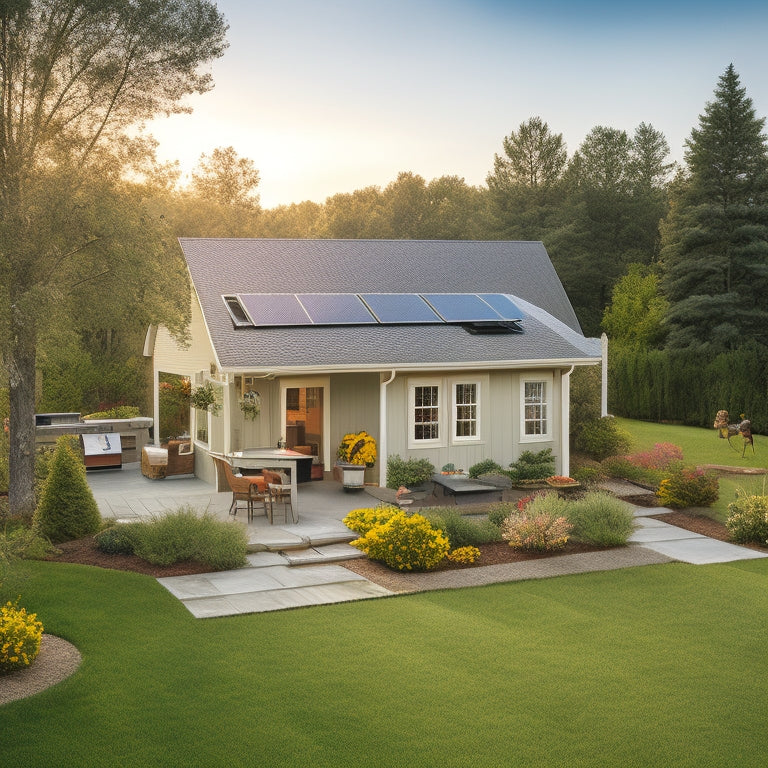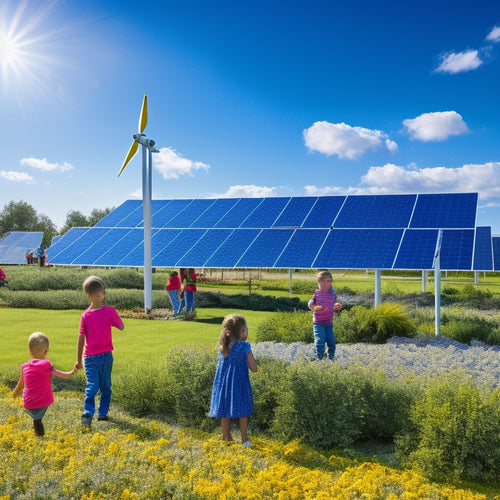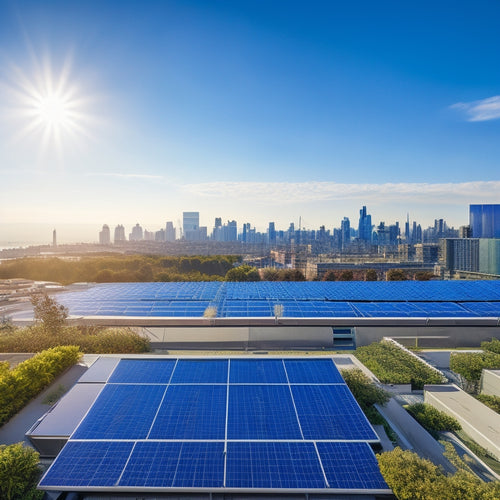
A Beginner's Guide to Setting Up Solar Panels in 7 Steps
Share
You're about to commence a life-changing expedition, switching to a sustainable energy source that can greatly reduce your carbon footprint and save you money on utility bills. To get started, begin by evaluating your energy needs, reviewing past utility bills and conducting an energy audit to identify areas for improvement. Next, choose the right equipment, selecting solar panels and inverters that maximize energy production and minimize costs. Then, find a qualified installer, preparing your roof and site for installation. From there, you'll connect to the grid, monitor performance, and maintain your system. As you take these initial steps, you'll uncover a wealth of possibilities to optimize your solar panel setup.
Key Takeaways
- Assess your energy needs by reviewing past utility bills and conducting an energy audit to determine the right solar panel system size.
- Choose the right equipment by selecting high-efficiency solar panels and inverters with long warranties, and considering additional features that enhance performance.
- Select a qualified installer with NABCEP certification, 5+ years of experience, and a strong customer review rating to ensure a successful installation.
- Ensure your roof and site are suitable for solar panels by assessing orientation, shading, structural integrity, and aesthetics before installation.
- Regularly monitor and maintain your solar panel system to optimize energy production, address potential issues, and ensure long-term performance.
Assessing Your Energy Needs
As you begin on utilizing solar energy, analyzing your energy needs becomes an essential first step. You need to determine how much energy your home consumes to size your solar panel system accurately. Start by reviewing your past utility bills to identify your average daily energy consumption in kilowatt-hours (kWh). This will give you a clear illustration of your energy usage patterns.
Next, conduct an energy audit to identify areas in your home that can be improved for better efficiency. Check for air leaks, insulation, and energy-efficient appliances. This will help reduce your energy consumption, making it easier to shift to solar power.
Evaluating your energy needs also involves considering your energy goals. Are you looking to power your entire home or just a portion of it? Answering these questions will help you determine the right size of your solar panel system.
Choosing the Right Equipment
Efficiency is the cornerstone of a successful solar panel system, and it begins with selecting the right equipment.
You'll want to choose equipment that maximizes energy production while minimizing costs.
When selecting solar panels, consider the following factors:
- Solar panel types: Monocrystalline, polycrystalline, and thin-film panels each have their advantages and disadvantages. Monocrystalline panels are the most efficient but also the most expensive. Polycrystalline panels offer a balance between efficiency and cost. Thin-film panels are the least expensive but also the least efficient.
You should also consider the equipment warranties offered by manufacturers.
Look for warranties that cover the panels' performance, materials, and workmanship for at least 25 years. Additionally, consider the warranty period for inverters, which typically range from 10 to 25 years.
Selecting a Qualified Installer
You've selected the right equipment for your solar panel system; now it's time to find a qualified installer to bring it all together. This is an essential step, as a skilled installer can guarantee your system is installed correctly and efficiently.
When selecting an installer, consider the following key factors:
| Installer Qualifications | Installation Certifications | Customer Reviews |
|---|---|---|
| NABCEP certification | UL certification | 4.5-star rating or higher |
| 5+ years of experience | OSHA certification | Online reviews from multiple sources |
| Local licenses and permits | ||
| Insurance coverage | ||
| Manufacturer training |
Additionally, ask about cost estimates, warranty options, and service agreements. Confirm the installer is familiar with local regulations and can provide a realistic installation timeline. By doing your due diligence, you'll find an installer who can expertly handle your solar panel installation.
Preparing Your Roof and Site
Before the installation process begins, your solar panel installer will need to assess your roof and site to verify they're suitable for the solar panel system. This assessment is vital to guarantee your solar panels operate at maximum efficiency.
During the assessment, your installer will evaluate the following key factors:
-
Roof orientation: Your roof's direction and angle will impact the amount of sunlight your solar panels receive. An ideal orientation is south-facing with a tilt between 15° and 45°.
-
Shading analysis: Trees, buildings, and other obstructions can cast shade on your solar panels, reducing their energy output. Your installer will identify potential shading issues and recommend solutions.
-
Structural integrity: Your roof must be able to support the weight of the solar panels and withstand environmental elements like wind and rain.
Installing the Solar Panel System
You'll begin the installation process by mounting the solar panels on your roof, ensuring they're securely fastened to withstand environmental elements.
Next, you'll connect the inverters, which convert the DC power generated by the panels into AC power compatible with your home's electrical system.
Properly connecting the inverters is essential to achieving ideal energy production and system safety.
Mounting the Panels
Most solar panel systems require a sturdy mounting structure to secure the panels to your roof or the ground. This is vital for guaranteeing the structural integrity of your solar panel system, as it will be exposed to various weather conditions.
When mounting the panels, you'll need to take into account the following:
-
Panel Orientation: The panels should be installed at an ideal angle to maximize energy production. This typically ranges from 15 to 40 degrees, depending on your location and roof pitch.
-
Mounting Options: You have two primary mounting options: roof-mounted and ground-mounted systems. Roof-mounted systems are more common, but ground-mounted systems can be more efficient and easier to install.
-
Weather Considerations: Verify your mounting structure can withstand extreme weather conditions, such as high winds and heavy snowfall. Additionally, think about the aesthetic impact of your mounting system, as it will be visible from the ground.
Remember to follow installation guidelines and confirm secure fastening to prevent damage to your roof or the solar panels. Proper mounting is essential for a safe and efficient solar panel system.
Connecting the Inverters
With the mounting structure securely in place, your solar panel system's electrical backbone - the inverter - is ready to be connected. Now it's time to select the right inverter for your system. You'll need to take into account inverter types, such as string inverters, microinverters, and power optimizers. Each type has its pros and cons, so it's crucial to choose the one that best suits your system's requirements.
| Inverter Type | Efficiency Rating |
|---|---|
| String Inverter | 95-98% |
| Microinverter | 95-97% |
| Power Optimizer | 97-99% |
| Central Inverter | 98-99% |
| Hybrid Inverter | 95-98% |
When connecting the inverter, verify it's compatible with your solar panel system's voltage and current ratings. Consult the manufacturer's instructions for specific connection protocols. Remember to follow all safety guidelines when working with electrical components. A well-connected inverter will optimize your system's energy production, so take your time and get it right.
Connecting to the Grid
You'll need to decide on a grid connection option that suits your setup, whether it's a standard grid-tie system or a more advanced microgrid configuration.
Regardless of the option you choose, you'll likely want to take advantage of net metering, which allows you to sell excess energy back to the grid and offset your utility bills.
Grid Connection Options
The primary advantage of connecting your solar panel system to the grid is the ability to sell excess energy back to your utility company and offset your electricity costs.
This grid connection option allows you to take advantage of the grid's reliability and stability, ensuring a steady supply of power even when your solar panels aren't producing energy.
You have three main grid connection options to choose from:
-
Grid-tied systems: These systems connect your solar panels directly to the grid, allowing you to sell excess energy back to the utility company. This is the most common type of grid connection.
-
Hybrid solutions: These systems combine grid-tied systems with battery storage, allowing you to store excess energy for later use and providing backup power during outages.
-
Off-grid systems with grid backup: These systems allow you to operate off the grid, but still connect to the grid for backup power during periods of low energy production.
When choosing a grid connection option, consider your energy needs, budget, and goals.
Each option has its advantages and disadvantages, so it's crucial to weigh your options carefully before making a decision.
Net Metering Benefits
One of the most attractive benefits of connecting your solar panel system to the grid through net metering is that it allows you to offset your electricity costs by selling excess energy back to your utility company. This means you can generate revenue from your solar panels while also reducing your energy bills.
With net metering, you'll receive credit for the excess energy you produce, which can be used to offset your energy consumption during periods of low solar production. This leads to significant cost savings, especially for households with high energy demands.
Moreover, net metering enables you to make a positive environmental impact by feeding clean energy back into the grid. By generating electricity locally, you reduce the strain on the grid and decrease greenhouse gas emissions. This not only benefits the environment but also increases the overall efficiency of the energy system.
With net metering, you can track your energy production and consumption in real-time, giving you greater control over your energy usage and costs. By utilizing the power of solar energy, you can reduce your reliance on fossil fuels and contribute to a cleaner, more sustainable future.
Monitoring and Maintaining Performance
During routine system checks, simultaneously review your solar panel's performance metrics and inspect its physical condition to identify potential issues before they escalate into major problems.
This proactive approach guarantees you're always enhancing your system's energy production and minimizing downtime.
To guarantee peak performance, follow these maintenance guidelines:
-
Schedule regular cleaning: Dust and debris can greatly reduce your solar panels' energy output. Develop a cleaning schedule to maintain peak performance.
-
Track energy monitoring data: Analyze your energy monitoring data to identify trends, patterns, and anomalies that may indicate system issues.
-
Perform routine inspections: Regularly inspect your system's physical components, including the inverter, to identify potential issues before they affect performance.
Frequently Asked Questions
Can I Install Solar Panels on a Metal or Tile Roof?
You can install solar panels on a metal or tile roof, but you'll need to take into account specialized metal roof installation brackets and tile roof considerations, such as waterproofing and structural integrity, to guarantee a secure and efficient setup.
How Long Does It Take to See a Return on Investment?
You'll typically see a return on investment within 5-7 years, depending on your location and system size, thanks to a shorter payback period enabled by financial incentives like tax credits and rebates that offset initial costs.
Are Solar Panels Affected by Shade or Weather Conditions?
You'll notice a significant shade impact on your solar panel efficiency, as even partial shade can reduce energy output by up to 50%. Additionally, weather effects like fog, haze, or heavy snowfall can also diminish performance, so ideal panel placement is essential.
Can I Add More Panels to My System in the Future?
As you scale up your sustainable sanctuary, you'll find it's smooth sailing to supplement your setup: evaluating expansion feasibility is essential, and ensuring system compatibility is vital for a seamless upgrade, allowing you to utilize more horsepower from the sun.
Will Solar Panels Increase My Property Value?
You'll enhance your property value with solar panels, as a property appraisal will reflect the increased energy efficiency, making your home more attractive to potential buyers and potentially increasing your resale value by up to 17%.
Conclusion
You've taken the first step towards utilizing the sun's energy, and now your expedition is about to shine brighter than ever! With your solar panel system up and running, you'll be generating clean energy and saving money in no time. Remember, your new system is like a well-oiled machine, requiring regular tune-ups to optimize its performance. Stay on top of maintenance, and you'll be basking in the rewards of renewable energy for years to come.
Related Posts
-

Solar Power for Community Energy Independence
Solar power is essential for your community's energy independence, offering both environmental and economic benefits....
-

High-Performance Energy-Efficient HVAC Systems
High-performance energy-efficient HVAC systems are essential for reducing energy consumption while improving indoor c...
-

Business Solar Investments for Cost-Effective Sustainability
Investing in solar energy is a smart move for your business, providing a solid foundation for cost-effective sustaina...


